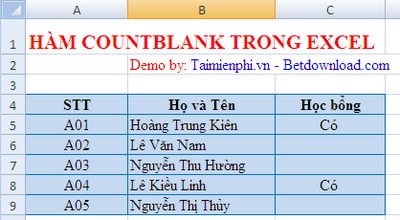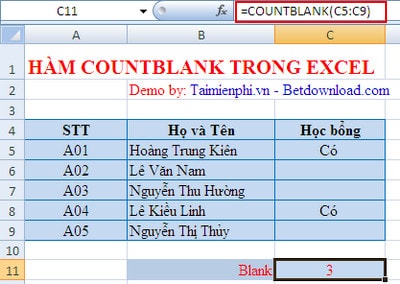Instructions for using the COUNTBLANK function in Excel
The COUNTBLANK function is an important tool in Excel, helping to determine the number of blank cells in a data range. Let's learn the syntax, usage and practical examples to apply effectively.
How to use the COUNTBLANK function
Syntax: COUNTBLANK(Range)
In there :
Range: The array selected to count the number of empty cells in it.
Note : Number 0 is not blank (empty cell).
Illustrative example : Given a list of a group of students who received and did not receive scholarships.
Students who did not get scholarships are denoted by empty cells. Count the number of students who did not get scholarships in that group.

The formula in cell B11 is: =COUNTBLANK(C5:C9)
We have the result:

The COUNTBLANK function in Excel counts the number of empty cells in a given range of data. This is a useful tool when checking for missing data in a spreadsheet, especially in statistics and large data processing. This function is often used to determine the number of empty cells in a list of students whose scores have not been entered, a list of customers whose information has not been updated, or a spreadsheet with empty cells that need to be processed.
When working with Excel data, combining the COUNTBLANK function with other functions such as IF, COUNTA , ISBLANK helps analyze data more effectively. For example, you can use COUNTBLANK to determine the number of blank cells, then combine it with the IF function to generate a warning if data is missing. This is especially important in list management, financial reporting, and tracking customer information.
You should read it
- How to calculate and color blank cells in Excel
- Get started with Excel for beginners
- Tips for adding in Excel you need to know
- How to fix the SUM function doesn't add up in Excel
- Guidance on how to align Excel correctly
- How to keep Excel and Excel columns fixed?
- What is ### error in Excel? how to fix ### error in Excel
- How to display 0 in front of a number in Excel
May be interested
- How to use the LEN function in Excel
 the len function in excel is used to measure the length of a certain string of characters, including spaces and correctly return the total character for the user.
the len function in excel is used to measure the length of a certain string of characters, including spaces and correctly return the total character for the user. - How to use the RANDARRAY function to randomly classify data in Excel
 the randarray function in excel allows you to sort random data in excel. below are details on how to use the excel randarray function.
the randarray function in excel allows you to sort random data in excel. below are details on how to use the excel randarray function. - How to use COUNTIF function on Excel
 the countif function on excel is the cell count function to satisfy the given condition, often used in statistics tables.
the countif function on excel is the cell count function to satisfy the given condition, often used in statistics tables. - How to use the MOD function and QUOTIENT function in Excel
 injury in excel has many ways of doing it, can be used manually or using the calculation function.
injury in excel has many ways of doing it, can be used manually or using the calculation function. - 8 little-known Excel functions that can save you a lot of work
 even seasoned excel users often find themselves stuck performing tasks manually that could be automated with a few clever functions.
even seasoned excel users often find themselves stuck performing tasks manually that could be automated with a few clever functions. - How to use MID functions to get strings in Excel
 mid function in excel is a function that takes the middle character string corresponding to the value that the user requires to perform.
mid function in excel is a function that takes the middle character string corresponding to the value that the user requires to perform. - How to use Excel's VALUE function
 excel's value function will convert a string to a digital form, which can be combined with other functions such as left function, right function, mid function.
excel's value function will convert a string to a digital form, which can be combined with other functions such as left function, right function, mid function. - Instructions for using the TRIMRANGE function to clean up Excel tables
 trimrange is a brand new excel function that is being rolled out to users. this new function has the ability to remove blank rows from a range of data.
trimrange is a brand new excel function that is being rolled out to users. this new function has the ability to remove blank rows from a range of data. - How to use the function to delete spaces in Excel
 deleting white space with functions in excel makes it easier for users to handle content, instead of traditional editing.
deleting white space with functions in excel makes it easier for users to handle content, instead of traditional editing. - How to fix the SUM function doesn't add up in Excel
 in the process of summing with sum in excel, you will encounter some errors such as not jumping the number, not adding the sum. so how to handle this problem?
in the process of summing with sum in excel, you will encounter some errors such as not jumping the number, not adding the sum. so how to handle this problem?










 MEDIAN function in Excel, how to use and examples
MEDIAN function in Excel, how to use and examples MINA function in Excel, how to use and examples
MINA function in Excel, how to use and examples How to use the COUNTIFS function in Excel
How to use the COUNTIFS function in Excel ABS function in Excel, formula, usage and examples
ABS function in Excel, formula, usage and examples MATCH function in Excel, usage and examples
MATCH function in Excel, usage and examples Detailed instructions for mail merge in Word 2010, 2013, 2016
Detailed instructions for mail merge in Word 2010, 2013, 2016